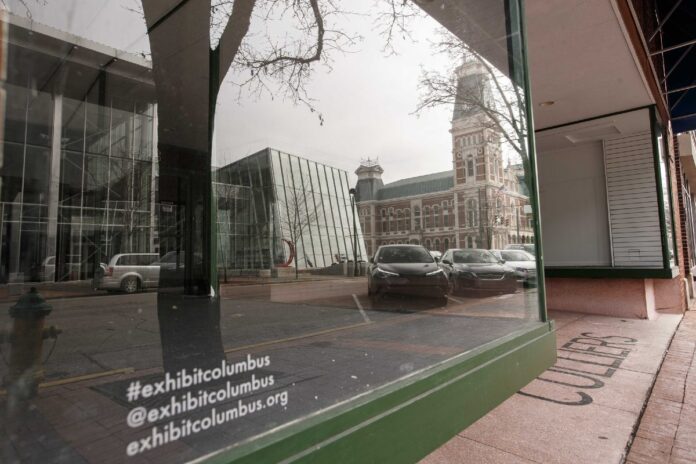
With its current strategic plan for downtown essentially fulfilled, Columbus stakeholders are embarking on a new effort to identify what improvements and new initiatives should come next.
The current strategic plan, created in 2005 by Development Concepts Inc., produced projects such as the redeveloped Commons, The Cole apartment building, Hotel Indigo, the redesigned Fourth Street, three parking garages and the Cummins downtown office space, said Jeff Bergman, the Columbus-Bartholomew County planning director.
With most of its ideas fulfilled, a new strategic plan is needed, Bergman said.
The process of creating the next vision for downtown kicked off Friday when a team from Philadelphia-based DAVID RUBIN Land Collective, the landscape architecture and urban design firm hired to guide the project, met with a committee of city, business and community leaders.
[sc:text-divider text-divider-title=”Story continues below gallery” ]
“Columbus has a long history of public-private partnerships, and part of that is building consensus about what will be valuable to the city,” Columbus Mayor Jim Lienhoop said.
Heritage Fund – the Community Foundation of Bartholomew County is overseeing the project locally with its 15-member Governance and Planning Committee and six additional individuals added to ensure the project has broad city representation, said Tracy Souza, Heritage Fund president and CEO.
The strategic planning process is expected to take six to seven months, and will include opportunities for public input, she said.
A $573,000 grant by The Cummins Foundation to Heritage Fund will cover the consulting firm’s cost, said Norbert Nusterer, a Cummins vice president who is president of its Power Systems business, but also serves as a Heritage Fund board member and member of its Governance and Planning Committee.
What’s next
New projects that are either underway or under consideration — such as the Riverfront and State Street Revitalization Project — could benefit from a new strategic plan, Lienhoop said.
The city envisions a redeveloped waterfront area downtown that would aid recreation and tourism, and has had some design work performed to show what that could look like.
Some work has been performed on the State Street project that connects to downtown, such as redeveloping the State Street bridge to make it more pedestrian-friendly, but additional redevelopment awaits.
With the razing of the Clarion Hotel and Conference Center on the city’s west side, Lienhoop said the city also needs to consider:
- Whether to promote growth in the hotel and lodging industry
- Whether a new conference center is needed
- How to promote additional retail activity downtown
“We need high-level direction for downtown, and it’s reasonable to assess what has been accomplished since 2004 and what our goals continue to be and what we want to have,” Bergman said.
The strategic planning process will identify projects that are a true benefit to the community, which will make it easier to gain private financial support, Lienhoop said.
Lienhoop also emphasized that while the downtown is a focal point, the strategic planning would not set boundaries on geographic areas or topics. That could mean the process identifies priorities on the city’s east or north sides, for example, or on topics such as education or addiction, he said.
Moving forward
The need for a new downtown strategic plan has been mentioned for the past few years, Bergman said. However, efforts to create one ramped up late last year.
Requests for proposals were sent to four firms in October, and they were returned in November. Interviews with the firms were conducted in December and DAVID RUBIN Land Collective was chosen the same month.
“We’re all impressed with the Land Collective group, with their creative ideas for engaging the public,” Souza said.
Those who chose DAVID RUBIN Land Collective as the consultant also were impressed with their work on projects in other communities, Souza said.
DAVID RUBIN Land Collective designed the landscape of Cummins Inc.’s new Distribution Business headquarters in Indianapolis. It also has designed the Indianapolis Museum of Art’s master plan for its 152-acre campus.
Funding to pay the consultant’s costs is coming from The Cummins Foundation’s architecture fund, said Nusterer, who presented the project to the Cummins Foundation a few weeks ago.
The Cummins Foundation historically has paid the architect fee for select projects — including Schmitt Elementary School, Fire Station No. 4, the Bartholomew County Veterans Memorial, Mill Race Center and the redeveloped Commons — but this time chose to fund the broader master planning activity, Nusterer said.
“We are excited and honored to contribute yet again as the community updates its road map towards an even more vibrant and economically viable downtown that serves an increasingly diverse set of city residents and visitors,” Nusterer said.
The process
Members of the Governance and Planning Committee have backgrounds in business, health, education, city government and philanthropy, but additional individuals were added who have backgrounds in the arts, architecture and municipal planning. That was done is to ensure a broad input of ideas, Souza said.
Actively listening to ideas from city leadership and Columbus residents will be integral in creating a new strategic plan for downtown, said David Rubin, the founding principal of the Land Collective.
The Land Collective team is a collaboration of firms including:
- HR&A, an economic consulting firm for real estate, development, program design and implementation
- NelsonNygaard for mobility, accessibility and sustainability
- Beyer Blinder Belle for issues of architecture and heritage/preservation
- Hagerman Group for cost estimation
- Impart Creative for website design
NelsonNygaard previously worked in Columbus consulting with the city’s parking implementation committee.
The strategic process starts with alignment exercises so that all involved understand what is to be achieved, Rubin said. The consulting group wants to know the “diamond in the rough in Columbus” and the city’s DNA, he said.
Rubin’s team will gather information and use it to establish alignment toward key goals of development. Strategic engagement will be used in multiple ways with the community, including personally and online, Rubin said.
“We want to make sure all the voices are heard — not just key stakeholders in a room, but the breadth of the community,” Rubin said.
Vetting ideas to examine what the community wants versus the costs involved in part of the process, he said, as is setting periodic milestones.
The hope is that by summer or early fall, the committee will have a final presentation of ideas to share with the public, Souza said.
The goal is to create a plan that is flexible and adaptable and resilient through time, and allows the city flexibility to shuffle and pursue goals depending on circumstances and resources available, Rubin said.
Envisioning impact
Bergman said the planning department would like to see a strategic plan that offers guidance about downtown areas, such as the Second and Third streets corridors, underdeveloped properties along the corridors, the Riverfront area and connections to some neighborhoods.
While Columbus has had strategic plans before, this one is important because of the competition among communities to attract and retain talent, Souza said.
“If you have a great job in a community but it’s not a community you want to live in, people won’t want to live there. You’ve got to have great jobs and a great community. They’re all looking for how to create the kind of community you want to live in and be involved and engaged,” she said.
The strategic planning process offers the city a blank slate to think about what projects will deliver the most benefit to the community, said Rick Johnson, chairman of the Governance and Planning Committee.
“It’s that opportunity to step back and look at all the choices we have and firm that up in a way that makes the most difference in the next five or 10 years,” Johnson said.
[sc:pullout-title pullout-title=”Who’s involved” ][sc:pullout-text-begin]
The city’s effort to create a new strategic plan for downtown Columbus includes the Governance and Planning Committee at Heritage Fund – the Community Foundation of Bartholomew County, six invited community leaders and Philadelphia-based consultant DAVID RUBIN Land Collective.
Members of the Governance and Planning Committee are:
Tony Gambaiani, First Financial Bank market president
Tom Harmon, CEO of Taylor Brothers Construction Company Inc. and president of Harmon Steel Inc.
Jesse Brand, Bender Lumber
Hutch Schumaker, Coca-Cola Bottling Co. president
Rick Johnson, Johnson Ventures owner, president, CEO
Jim Bickel, Columbus Regional Health president, CEO
Tony Moravec, owner of Blairex Laboratories and Applied Laboratories
Tracy Haddad, board member of Haddad Foundation and Columbus Indiana Philharmonic, and Exhibit Columbus organizing committee member
Mary Chandler, Cummins vice president for corporate responsibility, CEO of The Cummins Foundation
Norbert Nusterer, Cummins vice president, president of Power Systems
John Burnett, Community Education Coalition president, CEO
Jack Hess, CivicLab executive director
Jim Lienhoop, Columbus mayor
Mark Elwood, Elwood Staffing chairman, CEO
Tracy Souza, Heritage Fund president, CEO
Added individuals:
Richard McCoy, Landmark Columbus director
Cindy Frey, Columbus Area Chamber of Commerce president
Karen Niverson, Columbus Area Visitors Center executive director
Jason Hester, Greater Columbus Economic Development Corp. president
Mary Ferdon, city’s executive director of administration and community development
Jeff Bergman, Columbus-Bartholomew County planning director
[sc:pullout-text-end][sc:pullout-title pullout-title=”Project timeline” ][sc:pullout-text-begin]
Project timeline for Columbus creating a new strategic plan for the downtown area.
2017
October: Heritage Fund sends requests for proposal to four firms
November: Firms return requests
December: Firms interviewed; DAVID RUBIN Land Collective selected
2018
Feb. 16: Rubin team comes to Columbus to begin process of creating a new strategic plan, meets with Heritage Fund’s Governance and Planning Committee
Process of creating new strategic plan expected to take six to seven months. Will include opportunities for public feedback.
[sc:pullout-text-end]




